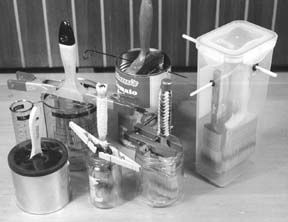
Poke your head up the hatch after waking up on board on a crystal clear morning in Port Townsend, WA’s Point Hudson marina and you may be blinded. Not by the sun. But by the shiny varnish on a great collection of wooden boats.
Often considered the wooden boat capital of the world, Port Townsend—at the top of the Olympic Peninsula—is a historic town of about 7,000 folks who love Victorian ways.
This burg has a fantastic collection of Victorian homes and buildings because it was abandoned suddenly around the turn of the century when better ports were developed, only to be vigorously revived in the 1920s.
Brion Toss, the renowned rigger, lives in there. So does Julie Anderson, owner-operator of Compass Rose Yacht Finishing. She does a lot of varnishing, and knows how important it is to take care of expensive varnish brushes.
She used to keep her badger hair brushes in cans with plastic lids, in which you cut an “X” to poke the handle through. Serious varnishers know that trick. The problem is that the bristles rest on the bottom of the container instead of being suspended. If left too long, you get some cloudy slime in the bottom of the can that resembles the yeast/bacteria “mother” that forms in vinegar.
However, if the brush is suspended, the bristles tend to shed debris, which settles to the bottom of the container, leaving the bristles clean. You can use paint thinner, turpentine, kerosene, vegetable oil, or any good clean oil or solvent.
At PS, we have for years suspended brushes that were in semi-continuous use in cobbled-up cans and jars (see photo). Saran Wrap and aluminum foil sometimes have been used as crude covers.
Julie has a much better idea.
Her new “Brush Keeper” is a tall plastic box with vinyl grommets inserted in holes to accept dowels on which four brushes (of two sizes) can be quickly mounted. The top has a four-way snap seal that doesn’t leak. The seals and snap top help contain the odors; slows down the evaporation, too.
The rig is sized for the popular Redtree brushes, but can be adapted for most any brushes—paint or varnish. And it can be carried aboard or ashore without fear of it leaking.
To make sure it remains upright, we would, if it was ours, mount the container, whose bottom is smaller than the top, in a box. The box might even have room for a couple of small cans of varnish (PS long ago decided that small, pint cans generally are preferable) and a few clean tunafish or catfood cans (which are an important part of PS’s varnish regimen).
The Brush Keeper sells for $19.99 (plus $5 for S&H). If you do your own varnishing and/or painting, it’s well worth the $24.99.
Contact – Compass Rose Yacht Finishing, 360/379-8640, www.compassrose.ws.
































